PALAZZO DUCALE
MUSEO CORRER
CA’ REZZONICO
PALAZZO MOCENIGO
CASA DI CARLO GOLDONI
CA’ PESARO
MUSEO FORTUNY
MUSEO DI STORIA NATURALE
TORRE DELL'OROLOGIO
Palazzo Ducale
For more than a thousand years, the Doge’s Palace was the heart and symbol of political life and public administration within the Venetian Republic. Hence when that Republic fell in 1797, its role inevitably changed.
Venice was subjected first to French rule, then to Austrian, and ultimately (in 1866) became part of a united Italy. Over this period the Palace was occupied by various administrative offices as well as housing the Biblioteca Marciana (from 1811 to 1904) and other important cultural institutions within the city.
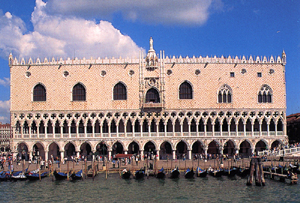 By the end of the nineteenth century the structure was showing clear signs of decay, and the Italian government set aside sizeable funds for extensive restoration. It was then that many of the original capitals of the fourteenth-century arcade were removed and substituted; the restored originals now forming the core of the collection in the Museo dell'Opera. What is more, all the public offices occupying the building were moved elsewhere, with the exception of the State Office for the Protection of Historical Monuments, which is still housed in the building under its modern title of the Superintendence for the Environmental and Architectural Heritage of Venice and its Lagoon. By the end of the nineteenth century the structure was showing clear signs of decay, and the Italian government set aside sizeable funds for extensive restoration. It was then that many of the original capitals of the fourteenth-century arcade were removed and substituted; the restored originals now forming the core of the collection in the Museo dell'Opera. What is more, all the public offices occupying the building were moved elsewhere, with the exception of the State Office for the Protection of Historical Monuments, which is still housed in the building under its modern title of the Superintendence for the Environmental and Architectural Heritage of Venice and its Lagoon.
In 1923 the Italian State, the owner of the building, appointed the Venice City Council to manage it as a museum open to the public.
Since 1996 the Doge’s Palace has been part of the network of museums that comes under the management of the Venice Museum Authority.
Opening times:
From 22th March to 2th November
9am - 7pm (ticket-office 9am - 6pm)
From 3th November to 21th March
9am - 5pm (ticket-office 9am - 4pm)
Closed on 25th December and 1st January
Webste: www.museiciviciveneziani.it
ACTV waterbus lines: 1 and 2 stopping at San Marco or San Zaccaria
Museo Correr
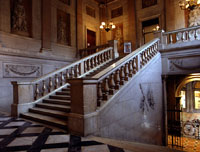 The Correr Museum takes its name from Teodoro Correr (1750-1830), a passionate art collector who was a member of an old family of the Venetian aristocracy. When he died in 1830, he left the city not only his works of art but also the palazzo at San Zan Degolà in which they were housed, plus funds to maintain and further extend a collection which was to bear his name and ultimately became the core around which the Venice Museum Authority developed. The Correr Museum takes its name from Teodoro Correr (1750-1830), a passionate art collector who was a member of an old family of the Venetian aristocracy. When he died in 1830, he left the city not only his works of art but also the palazzo at San Zan Degolà in which they were housed, plus funds to maintain and further extend a collection which was to bear his name and ultimately became the core around which the Venice Museum Authority developed.
Correr’s will was quite explicit about when and under what conditions his house was to be open to the public and to scholars, how many people were to work in maintaining the collection and even what funds were to be used for this purpose. These precise instructions indicate that what he had in mind was not only a place of scholarly research but also a veritable museum, a place in which to collect, conserve and exhibit works of various kinds.
However, initially the collection was not on display to the public as an organic whole; and though it was opened as early as 1836, it was only with its third Curator – Vincenzo Lazari – that one can say it became a museum proper. The objects within the collection were subdivided according to kind and carefully catalogued; and at the same time Lazari included new donations, purchased works with the museum’s funds and promoted restoration projects. As a result the museum was laid out as both a place of study for scholars and as an exhibition gallery containing noteworthy works and artefacts (in Lazzari’s own words “the best of what there is in each individual collection”). And although the curator was responsible for destroying objects and documents which he felt were not in keeping with the good name of the museum’s founder, it was due to his work that by the second half of the nineteenth century, the Correr had become a necessary stopping-off point for any scholars or visitors coming to Venice.
Thereafter the collection continued to grow through donations, bequests and acquisitions. From this core collection, the modern-day Venice Museum Authority would gradually emerge; and a series of different collections covering specific areas of the arts would eventually become a vast network of museums spread throughout the city.
Opening times:
From 22th March to 2th November
9am - 7pm (ticket-office 9am - 6pm)
From 3th November to 21th March
9am - 5pm (ticket-office 9am - 4pm)
Closed on 25th December and 1st January
Webste: www.museiciviciveneziani.it
ACTV waterbus lines: 1 and 2 stopping at San Marco or San Zaccaria
Cà Rezzonico
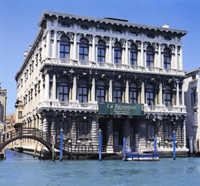 After some restoration work, the palace was adapted to serve as the Museum of Eighteenth-Century Venice and was opened to the public on 25th April 1936. The designers of the museum lay-out, Nino Barbantini and Giulio Lorenzetti, aimed to exploit the character of Ca' Rezzonico, arranging the works as if they were the palace's original furnishings. To achieve this result, numerous eighteenth-century works that belonged to the other civic museums of Venice were concentrated in Ca' Rezzonico, together with paintings, furniture and frescoes from other civic-owned buildings and many works purchased for the occasion on the antiques-market. The final effect was undeniably striking; despite one or two examples of straining for effect, the quality of the numerous works exhibited, together with the extraordinary quality of the architecture and the setting, made Ca' Rezzonico a veritable temple of the Venetian Settecento: an age of splendour, dissipation and decadence, but undoubtedly one of the most lively and fertile seasons of art in Europe. After some restoration work, the palace was adapted to serve as the Museum of Eighteenth-Century Venice and was opened to the public on 25th April 1936. The designers of the museum lay-out, Nino Barbantini and Giulio Lorenzetti, aimed to exploit the character of Ca' Rezzonico, arranging the works as if they were the palace's original furnishings. To achieve this result, numerous eighteenth-century works that belonged to the other civic museums of Venice were concentrated in Ca' Rezzonico, together with paintings, furniture and frescoes from other civic-owned buildings and many works purchased for the occasion on the antiques-market. The final effect was undeniably striking; despite one or two examples of straining for effect, the quality of the numerous works exhibited, together with the extraordinary quality of the architecture and the setting, made Ca' Rezzonico a veritable temple of the Venetian Settecento: an age of splendour, dissipation and decadence, but undoubtedly one of the most lively and fertile seasons of art in Europe.
From 22th March to 2th November
10am - 6pm (ticket-office 10am - 5pm)
From 3th November to 21th March
10am - 5pm (ticket-office 10am - 4pm)
Closed on Tuesdays and on 25th December, 1st January, 1st May
Webste: www.museiciviciveneziani.it
Galleria Internazionale d’Arte Moderna Cà Pesaro
In 1902, thanks to the bequest of the Duchess Felicita Bevilacqua La Masa, the Venice Town Council decided to use the palazzo to host the municipal collection of modern art, which had been started in 1897, the year of the second Venice Biennale.
Shortly afterwards, between 1908 and 1924, the ammezzato-storey was used to host the historic Bevilacqua La Masa Exhibitions, which, in lively contrast with the Venice Biennale, favoured a generation of young artists, including Boccioni, Casorati, Gino Rossi and Arturo Martini.
The collection was enriched over the years by further acquisitions and donations. The former mainly consisted of works bought by the Town Council at the Venice Biennale: up unto the 1950s European art was favoured, in agreement with the Galleria Nazionale d’Arte Moderna of Rome, which generally acquired Italian works at the Biennale.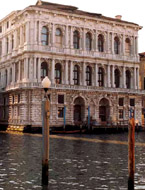
From the 1960s onwards a new policy was adopted, privileging Italian art. As a result there was a noticeable increase in the number of works by those artists already mentioned, who, thanks to the Bevilacqua La Masa Exhibitions and the polemics that surrounded them, had made Ca’ Pesaro famous as a driving force for innovation in Italian art. The collection of works from nineteenth-century Venice is also remarkable.
As for the donations, they started with the founding donation by Prince Alberto Giovanelli, followed by Baron Edoardo Franchetti, Baron Ernst Seeger, Filippo Grimani, but above all by Associazione Industriali e Commercianti Veneziani.
In 1914 a number of notable works in wax by Medardo Rosso were acquired, and in the sixties the De Lisi bequest enriched the gallery with works by Morandi, De Chirico, Carrà, Kandinsky, Mirò and Matta, thus filling certain gaps left by the municipal policy of acquisition; finally, in 1990 the gallery received the valuable Wildt donation.
Opening times:
NOTICE TO THE PUBLIC
- From July 29th to August 11th 2008
the Museum of Oriental Art will be closed to the public for important maintenance works of the staircase.
- The painting Giuditta II by Gustav Klimt is on loan in the exhibition "Gustav Klimt: Painting, Design and Modern Life in Vienna 1900", at the Tate Liverpool, from May 30th to August 31st 2008.
Webste: www.museiciviciveneziani.it
Palazzo Mocenigo
In 1945 Palazzo Mocenigo at San Stae was bequeathed to the city of Venice by Alvise Nicolò, the last descendant of the family, to be used "as a Gallery of Art, to supplement Museo Correr".
In 1985 the overall project of the Civic Museums designated Palazzo Mocenigo as the seat of the Museum and Study Centre of the History of Fabrics and Costumes: it contains the rich collections of ancient textiles and costumes mostly from the Correr, Guggenheim and Cini collections and the suppressed Centre of Palazzo Grassi.
Palazzo Mocenigo also contains a well-stocked library specialising in the history of fabrics, costumes and fashion.
The library is situated in the rooms on the first-floor piano nobile that have not conserved their original furnishings; the stocks of fabrics and costumes are situated on the first mezzanine and on the top floor. On the second mezzanine an area has been set aside for didactic and experimental activities.
From 22th March to 2th November 10am - 5pm (ticket-office 10am - 4.30pm)
From 3th November to 21th March 10am - 4pm (ticket-office 10am - 3.30pm)
Closed on Mondays and on 25th December, 1st January, 1st May
Webste: www.museiciviciveneziani.it
Museo Civico di Storia Naturale
With its imposing Grand Canal façade, the Fontego dei Turchi is one of the most famous secular buildings in Venice.
The core structure dates back to the 12th-13th century, and the double loggia in the so-called Venetian-Byzantine style reflects the purpose for which the building was created, as a trading depot for goods coming from the East; the corner towers are similar to the defensive structures that were part of Early Medieval family palazzi.
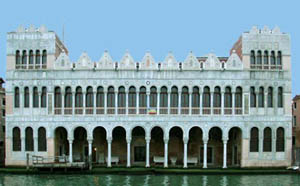 The original palazzo belonged to the Pesaro then to the D’Este families; in fact, tradition has it that such figures as Lucretia Borgia and Torquato Tasso stayed here. It was in 1621 that the structure became a trading depot reserved exclusively to Turkish merchants, a role it would continue to have right up to 1838.
The present appearance of the building is due to a radical nineteenth-century restoration, carried out when the City Council acquired the structure to house the collections of the Museo Correr. The original palazzo belonged to the Pesaro then to the D’Este families; in fact, tradition has it that such figures as Lucretia Borgia and Torquato Tasso stayed here. It was in 1621 that the structure became a trading depot reserved exclusively to Turkish merchants, a role it would continue to have right up to 1838.
The present appearance of the building is due to a radical nineteenth-century restoration, carried out when the City Council acquired the structure to house the collections of the Museo Correr.
When the Correr art and history collections were moved to their present home in St. Mark’s Square in 1922, the natural history and ethnography collections remained at the Fontego, which in 1923 was officially designated as Venice’s Museum of Natural History.
The structure opened to the public in 1928, with its displays also including the precious collections from the Istituto Veneto di Scienza, Lettere ed Arti.
Opening times:
Currently open to the public: the Ligabue Expedition Room and the Tegnue Aquarium
Tuesday - Friday 9/13 (entrance 9/12.30)
Saturday and Sunday 10/16 (entrance 10/15.30)
Closed on Mondays and on 25th December, 1st January, 1st May
Free entrance
Webste: www.museiciviciveneziani.it
Museo Fortuny
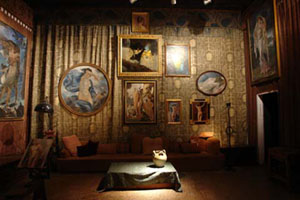
Once owned by the Pesaro family, this large Gothic palazzo in Campo San Beneto, was transformed by Mariano Fortuny into his own atelier of photography, stage-design, textile-design and painting.
The building retains the rooms and structures created by Fortuny, together with tapestries and collections. The working environment of Mariano Fortuny is represented through precious wall-hangings, paintings, and the famous lamps – all objects that testify to the artist’s inspiration and still give count of his eclectic work and of his presence on the intellectual and artistic scene at the turn of the nineteenth century.
The Fortuny Museum was donated to the city in 1956 by Henriette, Mariano's widow.
The collections within the museum comprise an extensive number of pieces and materials which reflect the various fields investigated in the artist’s work.
These are organised under certain specific headings: painting, light, photography, textiles and grand garments.
Opening times:
NOTICE TO THE PUBLIC
The Fortuny Museum is temporarily closed from August 18th to August 29th for the preparation of the exhibition GEORGE BARBIER (1882-1932) The birth of Art Déco.
Webste: www.museiciviciveneziani.it
Casa di Carlo Goldoni
Je suis né à Venise, l’an 1707, dans une grande et belle maison, située entre le pont de Nomboli et celui de donna onesta, au coin del rue de Ca’ Centanni, sur le paroisse de St. Thomas [I was born in Venice, in 1707, in a large and beautiful house situated between the Ponte dei Nomboli and the Ponte della Donna Onesta, at the corner of Calle di Ca’ Centanni, in the parish of San Tomà].
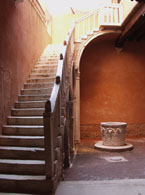 This is how the eighty-year-old Carlo Goldoni, by then a resident in Paris for twenty-five years, recalls where he was born at the opening of his Mémoires. Ca’ Centani, or Centanni - now better known as Casa di Carlo Goldoni - was built in the fifteenth century and has maintained all the features of Venetian Gothic architecture of that period. The particularly interesting aspects of the building are the three-part canal facade with its richly-decorated four-arched window, and the entrance giving onto Calle dei Nomboli, which leads into an atmospheric courtyard with an external two-flight staircase bound by a banister in small columns of Istrian stone. This is how the eighty-year-old Carlo Goldoni, by then a resident in Paris for twenty-five years, recalls where he was born at the opening of his Mémoires. Ca’ Centani, or Centanni - now better known as Casa di Carlo Goldoni - was built in the fifteenth century and has maintained all the features of Venetian Gothic architecture of that period. The particularly interesting aspects of the building are the three-part canal facade with its richly-decorated four-arched window, and the entrance giving onto Calle dei Nomboli, which leads into an atmospheric courtyard with an external two-flight staircase bound by a banister in small columns of Istrian stone.
Initially owned by the Rizzo family, the palazzo was rented to the Centanni family and became the centre of a very active artistic/literary Accademia in the 16th cent. Towards the end of the seventeenth century, Carlo Alessandro Goldoni - the playwright’s paternal grandfather and a notary from Modena - took up residence here. As mentioned above, Carlo Goldoni himself was born here in 1707 (25 February), and the building would remain the family home until 1719.
In 1914 Aldo Ravà, a noted scholar of eighteenth-century Venice - together with Count Piero Foscari and Commendatore Antonio Pellegrini - bought the palazzo from its owner, Contessa Ida Manassero Camozzo, with the idea of using it to house a museum dedicated to the great playwright and to the history of Italian theatre. The project came to nothing because of the outbreak of war, and then in 1931 Ca’ Centanni was donated to the City Council to be restored and - with a slight variation on the original scheme - turned into a Goldoni museum and a study centre for matters relating to theatre. Again, war held up the work, which was only completed in 1953, with the public opening in June of that year. The building housed a small museum of Goldoni memorabilia and artefacts relating to Venetian theatre, but focused primarily on its role as a study centre, with constant additions to its library and archive.
Opening times:
From 22th March to 2th November
10am – 5pm (Ticket office 10am – 4.30pm)
From 3th November to 21th March
10am - 4pm (Ticket office 10am – 3.30pm)
Closed on Wednesdays and on 25th December, 1st January, 1st May
Webste: www.museiciviciveneziani.it
ACTV waterbus lines: 1 and 2 stopping at San Marco or San Zaccaria
Linee Actv: 1 fermata San Tomà
Torre dell’Orologio
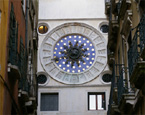 The Moors’ Clock Tower is one of the most famous architectural landmarks in Venice, standing over an arch that leads into what is the main shopping street of the city, the old Merceria. It marks both a juncture and a division between the various architectural components of St. Mark’s Square, which was not only the seat of political and religious power but also a public space and an area of economic activity, a zone that looked out towards the sea and also played a functional role as a hub for the entire layout of the city. The Moors’ Clock Tower is one of the most famous architectural landmarks in Venice, standing over an arch that leads into what is the main shopping street of the city, the old Merceria. It marks both a juncture and a division between the various architectural components of St. Mark’s Square, which was not only the seat of political and religious power but also a public space and an area of economic activity, a zone that looked out towards the sea and also played a functional role as a hub for the entire layout of the city.
In short, the Tower and its large Astronomical Clock, a masterpiece of technology and engineering, form an essential part of the very image of Venice. For more than five hundred years, they have measured out the flow of life and history within the city.
Useful information
Torre dell’Orologio
Piazza San Marco - Venezia
Tel: 041-5224064
ACTV waterbus lines: 1/2/3 San Marco boat stop |

